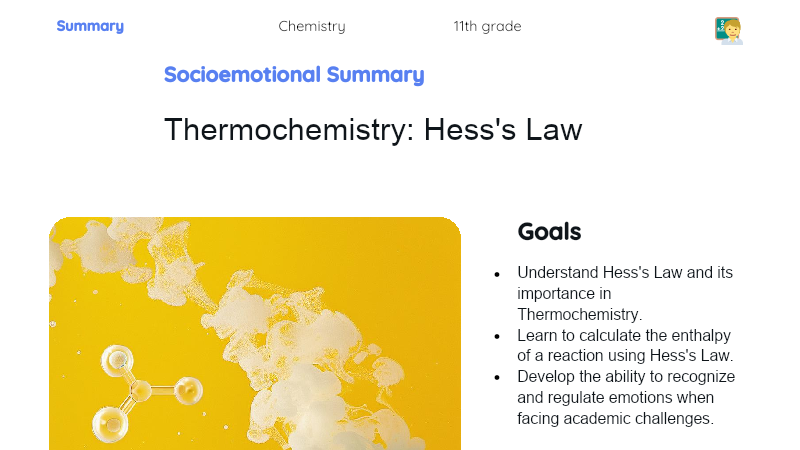Solutions: Introduction | Socioemotional Summary
Objectives
1. Understand that a solution is a homogeneous mixture composed of solute and solvent.
2. Differentiate the function of the solute and the solvent in a solution.
3. Apply knowledge of solutions in everyday contexts, such as making lemonade or preparing sweetened coffee.
4. Develop socioemotional skills, such as self-awareness and emotional regulation, through practical and reflective activities.
Contextualization
Did you know that when you make lemonade, you are actually applying a fundamental principle of Chemistry? 🎉 Mixing sugar in water creates a solution, where sugar is the solute and water is the solvent. Just like in Chemistry, in life we need to know how to 'dissolve' difficult emotions in a supportive environment to find balance and emotional well-being. 🌈✨ Let's explore together how solutions work and how this connects with our way of handling emotions!
Important Topics
Definition of Solution
A solution is a homogeneous mixture formed by two or more substances. In this mixture, the substance that is present in the greatest amount is called the solvent, while the substance that is present in the smallest amount is called the solute. Imagine lemonade: the sugar you dissolve in water is the solute, and the water is the solvent.
-
Homogeneous Mixture: The solution is uniform, meaning its properties are the same in any part of the mixture.
-
Solute: The substance that dissolves in the solvent. In the case of lemonade, sugar is the solute.
-
Solvent: The substance that dissolves the solute. In lemonade, water is the solvent.
-
Importance: Solutions are essential in our daily lives, from the beverages we consume to the medications we take.
Solvent
The solvent is the substance present in greater quantity in a solution and is responsible for dissolving the solute. A common example is water, which is a universal solvent due to its ability to dissolve many substances.
-
Main Substance: The substance that is present in greater quantity in the solution.
-
Dissolver: Has the property of dissolving other substances (solutes).
-
Example: In saline solution, water is the solvent.
-
Applications: Solvents are used in various industries, including pharmaceutical, food, and cosmetic.
Solute
The solute is the substance that is dissolved in the solvent. It is present in smaller quantity and spreads evenly throughout the solvent, forming the solution.
-
Minor Substance: The substance that is present in smaller quantity in the solution.
-
Dissolvable: Dissolves in the solvent to form a homogeneous mixture.
-
Example: In sweetened coffee, sugar is the solute.
-
Importance: Solutes can be solids, liquids, or gases and are fundamental for various chemical reactions and biological processes.
Key Terms
-
Solution: Homogeneous mixture of two or more substances.
-
Solvent: Substance that dissolves the solute.
-
Solute: Substance that is dissolved in the solvent.
-
Concentration: Amount of solute present in a specific amount of solvent.
-
Molarity: A way to express the concentration of a solution, in moles of solute per liter of solution.
To Reflect
-
How can you apply the concept of solution to solve emotional problems in your daily life?
-
In what way can understanding solute and solvent help you make more informed and responsible decisions?
-
How can practicing emotional regulation activities, such as guided meditation, improve your ability to handle challenging situations?
Important Conclusions
-
A solution is a homogeneous mixture composed of solute and solvent.
-
The solvent is the substance that dissolves the solute and is present in greater quantity.
-
The solute is the substance that is dissolved by the solvent, present in smaller quantity.
-
Knowing and understanding chemical solutions is fundamental both in Chemistry and in our daily lives, for example, when preparing beverages or medications.
-
Developing socioemotional skills, such as self-awareness and emotional regulation, is essential for facing academic and personal challenges.
Impact on Society
Currently, the understanding of chemical solutions has a significant impact on society. For example, in the creation of medications, it is essential to know how different substances dissolve to ensure the effectiveness of treatments. Moreover, by better understanding the properties of solutions, we can develop new products and technologies that improve our quality of life, such as healthier processed foods and more efficient cleaning products.
On a more personal and emotional level, understanding chemical solutions can be a powerful metaphor. Just as we learn to dissolve a solute in a solvent to create a homogeneous solution, we learn to dissolve difficult emotions in a supportive and understanding environment to achieve an emotionally balanced state. This skill is vital for our mental health and for building healthy relationships.
Dealing with Emotions
Let's use the RULER method to cope with our emotions while we study chemical solutions! First, recognize how you feel studying this topic. Are you excited? Frustrated? Understand why you are feeling this way: is it the difficulty of the topic or curiosity that is generating these emotions? Name your emotions accurately. Then, find appropriate ways to express these emotions: you can write about them or talk to a friend. Finally, regulate your emotions effectively, perhaps by taking deep breaths when you feel frustrated, or motivating yourself by remembering how useful this knowledge will be.
Study Tips
-
Make colorful summaries with drawings that represent chemical solutions. Visualizing helps a lot!
-
Establish connections with everyday situations. For example, remember solutions when making lemonade or coffee.
-
Practice meditation exercises to improve your focus and concentration while studying.



